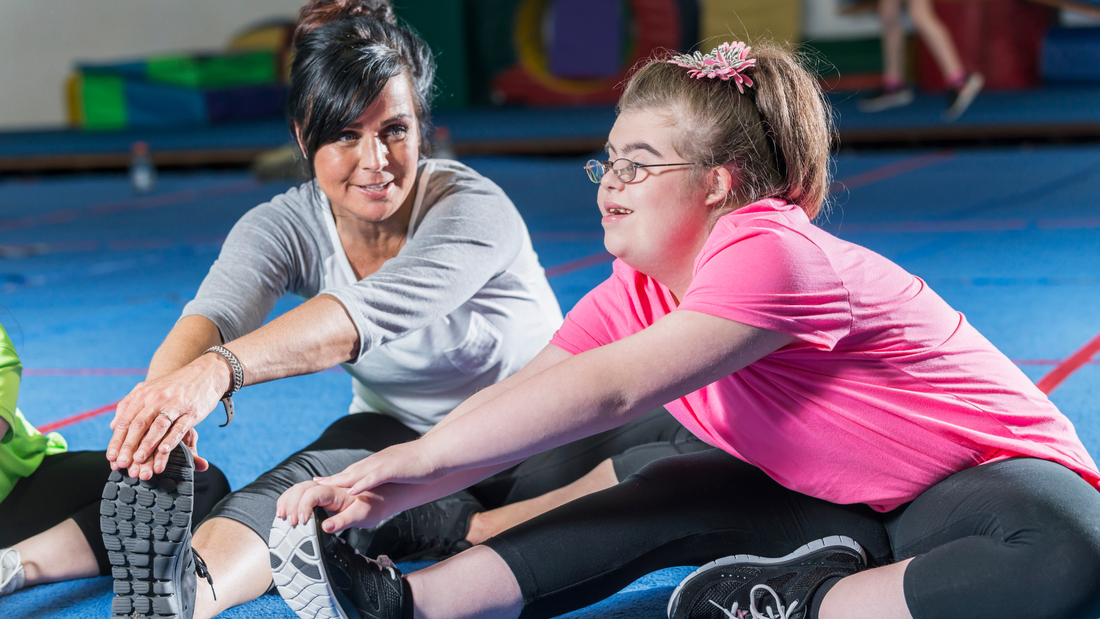|
People living with Down syndrome aren’t much different from everyone else. Everyone has different likes, dislikes, hobbies, interests, and talents. Just like you and me, those with Down syndrome can lead fulfilling lives that include getting an education, working, and becoming an integral part of their community.
However, where it seems we often draw the line for people with Down syndrome is getting them the exercise they need. Because of certain physical limitations, well-intentioned parents and teachers encourage children or teens with Down syndrome to abstain from physical activity. Although the intention to keep the child safe is commendable, regular physical activity helps people with Down syndrome mitigate the effects of lower muscle tone and hyper flexibility. Today, we’ll go over a few exercises that can keep these individuals safe while helping them stay in shape – while having fun doing it! What is Down Syndrome? Down syndrome is a genetic condition that causes a baby to be born with an extra chromosome called Chromosome 21 or Trisomy 21. This extra chromosome causes delayed mental and physical development, along with a greater risk of health problems. Although individuals with Down syndrome can share common physical characteristics, each person has different medical challenges and abilities. Some people with Down syndrome require quite a bit of medical attention, while others can live a more independent lifestyle. Down syndrome occurs by chance and is not dependent on a parent’s lifestyle. However, the medical challenges that come alongside living with Down syndrome can be managed with the right resources and effective planning. The Symptoms of Down Syndrome Everyone with Down syndrome has different symptoms that affect their intellectual and physical development. While some people with Down syndrome live quite healthy lives, but some have significant health issues. People with Down syndrome can still live healthy, happy lifestyles, regardless of their symptoms. In most cases, people with Down syndrome exhibit these characteristics:
Sometimes, people with Down syndrome also exhibit behavioral problems, which may arise when they cannot communicate their needs effectively. For example, they may exhibit stubbornness, tantrums, obsessive behaviors, and difficulty paying attention. Furthermore, people with Down syndrome sometimes have cognitive challenges that cause delays in developing speech and motor skills. The Importance of Exercise for Individuals with Down Syndrome Research shows that people with Down syndrome have much lower levels of physical activity than people without Down syndrome. However, a regular exercise routine can help people with Down syndrome manage their symptoms and have a healthier lifestyle. While Down syndrome can have varying symptoms, one of the most common symptoms is a lack of muscle tone, also known as hypotonia. Consequently, they may struggle with fine-tuned hand movements and daily activities. Stretching and strengthening the body ensures that people with Down syndrome avoid injury while finding it much easier to engage in regular daily activities. 5 Exercises for Individuals with Down Syndrome Whether a person is differently-abled or not, it’s important to work with a qualified healthcare professional before starting a new exercise program. Once they give you the green light, you can get started with these five easy exercises for people with Down syndrome. 1. Balance Exercises Having a sense of balance is crucial to the development of motor skills and allows a person to move through the world with ease. Whether climbing stairs or walking across campus, balance exercises will help people with Down syndrome manage their symptoms. If you’re not sure where to start, begin with the following balance exercises:
Adding these Down syndrome exercises to an exercise routine is essential because people with Down syndrome often compensate for their hypermobility and hypotonia by shifting their weight to their joints. Although this allows them to gain stability, it can cause long-term problems. 2. Core Exercises Core strength sets the stage for a well-rounded fitness regime and greatly reduces the risk of injury. Since Down syndrome causes low muscle tone and hypermobility, adding core exercises to a Down syndrome exercise routine will help people have the strength to participate in other fitness activities. Additionally, it’s important for people with Down syndrome to strengthen rotation muscles because it improves their motor skills. Add these movements to the exercise routine for a stronger core:
Since people with Down syndrome have less core stability, they often avoid rotation by moving two-dimensionally. However, the right core exercises will correct this imbalance, while reducing any physical discomfort. 3. Aerobic Exercises Down syndrome puts a person at high risk for heart-related problems, so it’s important for an individual with down syndrome to partake in exercises that improve their cardiovascular health. Aerobics exercises can help them build the strength and stamina necessary to become more independent. These fun exercises will improve cardiovascular health and overall physical fitness:
While any of these exercises can be performed with others, adaptive fitness exercise classes will allow your loved one to get in shape with people who are just like them! Sometimes, a sense of community provides the motivation to get in shape. If you’re not sure where to start, we provide online fitness classes at Let’s Go Fitness, where people with diverse abilities like Down syndrome can get moving with adaptive fitness specialists. 4. Pushing and Pulling Exercises Upper body strength is an essential part of any strength training routine, but this is especially important for people who are differently-abled. Pushing and pulling exercises will strengthen the muscles that are responsible for mobility, flexibility and a healthy posture. These exercises will help you strengthen your upper body:
Incorporating a balanced mix of pushing and pulling Down syndrome exercises into a workout routine ensures the balanced development of strength throughout the entire body. 5. Knee-Dominant Exercises Of course, you’ll need to strengthen your lower body as well for a balanced fitness regime. A strong lower body makes it much easier to move around on your own and help you participate in the fun activities you enjoy. Try out these knee-dominant exercises to strengthen your lower body and mitigate hypermobility:
These exercises can get a little challenging because they require a strong core and lower body to maintain balance. Make sure that people with Down syndrome are under the guidance and supervision of an adaptive fitness specialist to avoid injuries. Start a Down Syndrome Exercise Regime with Let’s Go Fitness At Let's Go Fitness, we strive to create a welcoming environment where you can make friends, get in shape, and have fun doing it! Our adaptive fitness specialists will guide you every step of the way. Whether you need accommodations, modifications, or simply an understanding listener, we'll help you reach your goals. Are you ready to start your fitness journey? Contact Let's Go Fitness today to learn more about our membership packages!
0 Comments
Staying active is an integral part of a healthy lifestyle, even if you have cerebral palsy. Cerebral palsy can make it challenging to get moving, but a regular exercise routine can help you manage your symptoms while reducing the risk of cardiovascular disease, hypertension, diabetes, and stroke. Staying active also positively impacts your mental health and reduces any physical pain from your condition.
Working out can be fun, especially when you’re with friends! These cerebral palsy exercises will help you get in shape and have a great time doing it. What is Cerebral Palsy? The term “cerebral palsy” refers to a group of disorders that impact an individual’s ability to move or maintain balance and posture. Cerebral palsy (CP) is the most prevalent motor disability, and about 18 million people worldwide have cerebral palsy. There are four primary types of cerebral palsy including:
5 Exercises for People with Cerebral Palsy You’ll need to work with a qualified healthcare professional before beginning a new exercise program to ensure that your fitness regime is safe and effective. These fun exercises will help you get started on your fitness journey! 1. Joint Rotations If you have cerebral palsy, you probably struggle with tight muscles and a limited range of motion. In this case, joint rotations are a great way to alleviate your symptoms. During this cerebral palsy exercise, you will perform rotations on your neck and all of your major joints, such as the following:
2. Stretching Cerebral palsy can make it challenging to maintain postural control, but regular stretching can ease stiff muscles and make it easier to stay balanced throughout your daily life. The right cerebral palsy exercises will promote circulation while reducing spasticity. Make sure you stretch the following muscles on a regular basis:
3. Wheelchair Aerobics When you’re working out with adaptive fitness specialists, they have the expertise necessary to adapt almost any exercise program to your motor impairments. Even if you have cerebral palsy, it’s essential to get your cardio exercise a few times a week to maintain healthy blood pressure. If your cerebral palsy mostly affects one side of your body or your legs, wheelchair aerobics is the ideal cerebral palsy exercise because it allows you to perform upper body movements while seated. 4. Resistance Band Training Cerebral palsy exercises that improve strength provide unparalleled benefits for increased muscle power, better posture, and improved balance. When you begin working out with adaptive fitness specialists, they recommend starting at a low level and gradually increasing the intensity as your fitness improves. There are plenty of effective cerebral palsy exercises that incorporate resistance bands. For instance, you could perform seated upper body training to strengthen your upper back and shoulders. You can also use resistance bands to build muscle in your chest and core to improve balance. 5. Aquatic Exercises Aquatic therapy is a specific type of rehabilitative therapy that takes place in a swimming pool, and it can be customized to minimize your specific symptoms. Aquatic therapy is the ideal tool for several water-based cerebral palsy exercises, such as the following:
Finding a Cerebral Palsy Exercise Group When you have cerebral palsy or another ambulatory condition, finding fitness instructors that understand your needs can be challenging. Consequently, you may get most of your exercise in physical therapy and other clinical settings. The great news is there are plenty of ways to get moving and get in shape with adaptive fitness specialists while making a few friends along the way! At Let’s Go Fitness, we create a safe space where differently-abled people can connect while getting in shape. Let’s Go Fitness At Let's Go Fitness, we strive to create a welcoming environment where you can make friends, get in shape, and have fun doing it! Our adaptive fitness specialists will guide you every step of the way. Whether you need accommodations, modifications, or simply an understanding listener, we'll help you reach your goals. Are you ready to start your fitness journey? Contact Let's Go Fitness today to learn more about our membership packages! |
ABOUTLet's Go Fitness's blog page keeps you up to date with educational and instructional information for training with diverse abilities. Archives
June 2023
Categories |
Let's Go Fitness
© 2020 Let's Go Fitness is an online fitness platform for people of all abilities.



 RSS Feed
RSS Feed